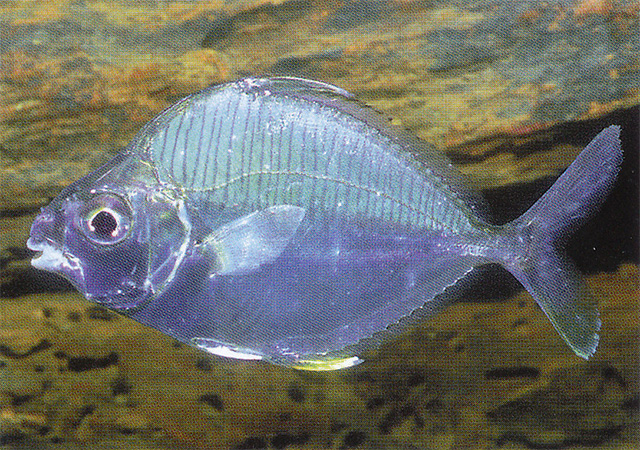| Leiognathidae (Slimys, slipmouths, or ponyfishes), subfamily: Leiognathinae |
| 28 cm TL (male/unsexed) |
|
demersal; freshwater; brackish; marine; depth range 10 - 110 m, amphidromous |
| Indo-West Pacific: Red Sea, Persian Gulf and East Africa (including Reunion, Comoros, Seychelles, Madagascar and Mauritius) to Fiji, north to the Ryukyu Islands, south to Australia. |
|
Dorsal spines (total): 8-8; Dorsal soft rays (total): 15-16; Anal spines: 3-3; Anal soft rays: 14-15. This species is distinguished by the following characters: body very deep, compressed, with a strongly humped back; body depth 1.7-1.9 times in standard length; mouth pointing downward when protracted; gill rakers short and fleshy, less than 1/2 length of corresponding gill lamellae, total gill rakers on first gill arch 18-22; head and breast scaleless; tubed scales on lateral line 61-66. Colour of adults, back greyish, belly silvery and many parallel close-set faint bars on back; usually a dark brown saddle on caudal peduncle; axil of pectoral fins grey to black; margin of soft dorsal fin black; both caudal-fin lobes with broad dusky margins; pectoral, pelvic, and anal fins colourless to yellowish. In juveniles (5-7 cm TL), thin, closely arranged, grey vertical lines descending from back to about midheight; membrane between anal-fin spines conspicuously yellow; posterior margin of caudal-fin lobes pale yellow and dusky; other fins hyaline; snout dotted black (Ref. 47581). |
| Found in river mouths and muddy inshore areas (Ref. 2847, 37816), often in mangrove areas (Ref. 48635). Adults are coastal inhabitants found on soft bottoms, usually between depths of 10-70 meters. Juveniles are commonly found in mangrove estuaries and tidal creeks, sometimes entering the lower reaches of freshwater streams (Ref. 44894). Adults move in schools. Frequently ascend into freshwater reaches of rivers (Ref. 12693). Active by day (Ref. 12693). Feed on polychaetes, small crustaceans, small fishes (Ref. 30573) and worms (Ref. 12693). Important food fish in the tropics (Ref. 4376). Caught near the bottom with bottom trawls, set nets, push nets, dip nets, and beach seines. In Indian waters, schools near the surface during April-May when caught with drift gill nets. Larger specimens sorted for human consumption and marketed fresh or dried-salted, but surplus fish used to feed ducks, converted to fishmeal, or discarded (Ref. 47581). |
|
Least Concern (LC); Date assessed: 02 July 2016 Ref. (130435)
|
| harmless |
Source and more info: www.fishbase.org. For personal, classroom, and other internal use only. Not for publication.

